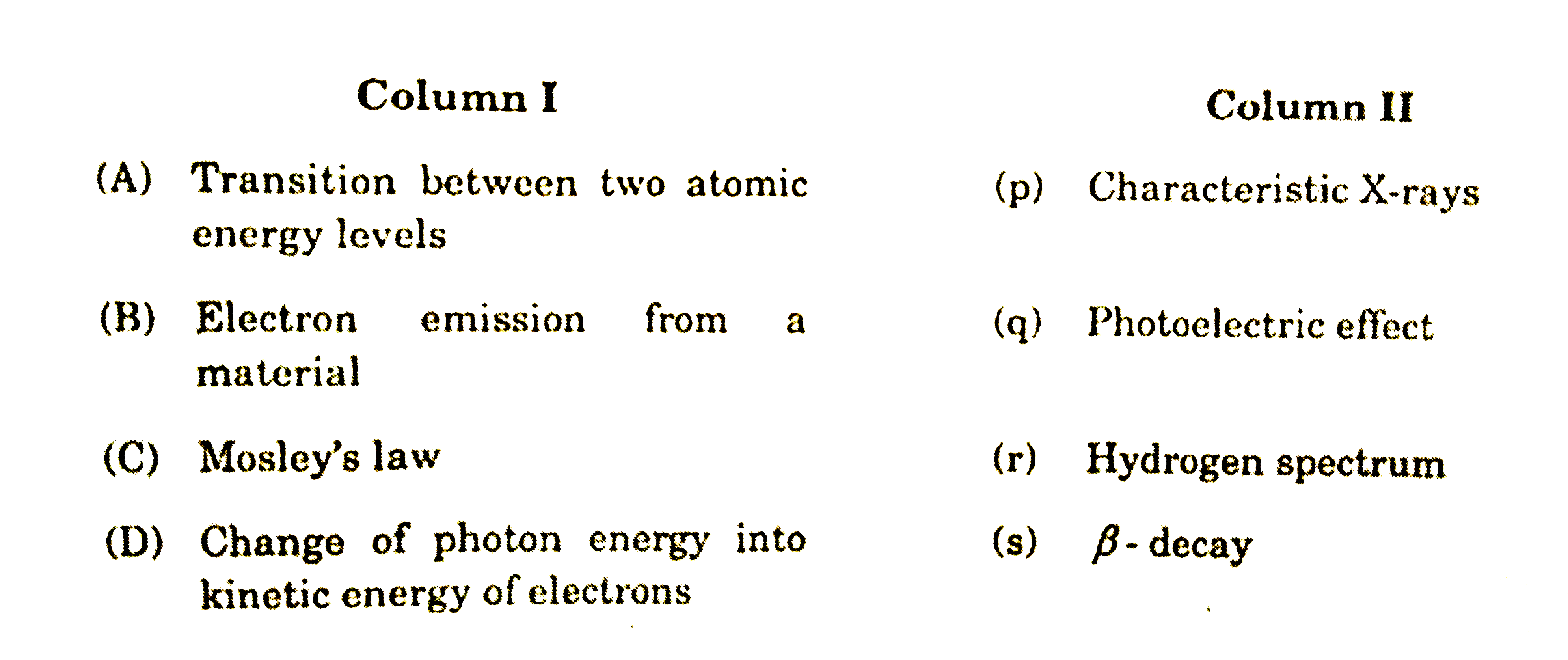Some laws/processes are given in column-I. Match these with the physical phenomena given in column-II.
Column IColumn II(A)Transition between two atomic energy levels.(p)Characteristic X-rays(B)Electron emission from a material(q)Photoelectric effect(C)Moaley's law(r)Hydrogen spectrum(D)Change of photon energy into kinetic energy of electrons(s)β−decay
The correct Answer is:(A) p,r; (B) p,q,s;(C ) p; (D) q
Step by step video & text solution for Some laws/processes are given in column-I. Match these with the physical phenomena given in column-II. {:(,"Column I",,"Column II"),((A),"Transition between two atomic energy levels".,(p),"Characteristic X-rays"),((B),"Electron emission from a material",(q),"Photoelectric effect"),((C),"Moaley's law",(r),"Hydrogen spectrum"),((D),"Change of photon energy into kinetic energy of electrons",(s),beta-"decay"):} by Physics experts to help you in doubts & scoring excellent marks in Class 12 exams.
Updated on:21/07/2023Topper's Solved these Questions
- SIMPLE HARMONIC MOTIONBOOK - ALLENCHAPTER - SIMPLE HARMONIC MOTIONEXERCISE - Paragraph
3 Videos
- SIMPLE HARMONIC MOTIONBOOK - ALLENCHAPTER - SIMPLE HARMONIC MOTIONEXERCISE - Subjective
30 Videos
- SIMPLE HARMONIC MOTIONBOOK - ALLENCHAPTER - SIMPLE HARMONIC MOTIONEXERCISE - MCQ s one or more than one correct answers
5 Videos
- RACEBOOK - ALLENCHAPTER - RACEEXERCISE - Basic Maths (Wave Motion & Dopplers Effect) (Stationary waves & doppler effect, beats)
25 Videos
- TEST PAPERBOOK - ALLENCHAPTER - TEST PAPEREXERCISE - PHYSICS
4 Videos
Similar Questions
Some laws/processes are given in Column I. Match these with the physical phenomena given in Column II and indicate your answer by darkening appropriate bubbles in the 4×4 matrix given in the ORS.
Column IColumn II(A)Transition between two atomic energy levels(P)Characteristic X-rays(B)Electron emission from a material(Q)Photoelectric effect(C)Mosley’s law(R)Hydrogenspectrum(D)Change of photon energy into kinetic energy of electrons(S)β−decay
View SolutionSome laws/processes are given in column-I. Match these with the physical phenomena given in column-II.
Column IColumn II(A)Nuclear fusion(p)Converts some matter in energy(B)Nuclear fission(q)Generally possible for nuclei with low aoimic number.(C)β−decay(r)Generally possible for nuclei with high. atomic no.(D)Exothermic nuclear reaction(s)essentially proceeds by weak nuclear forces.
View Solution
Knowledge Check
Match the elements given in column (I) with the most appropriat expected values given in column II
Column IColumn IIElementElectronegative valuesA.F(p)3.5B.O(q)3.0C.N(r)4.0D.C(s)2.5AA(r ), B(p),C(q),D(s)BA(s),B(q),C(r ),D(p)CA(p),B(q),C(r ),D(s)DA(r ),B(q), C(p),D(s)Match the organisms given in column I with the processes given in column II:
Column IColumn II(i)Leech(a)Holozoic nutrition(ii)Amoeba(b)Autotrophic nutrition(iii)Mushroom(c)Parasitic nutrition(iv)Green plant(d)Saprophytic nutritionA(i) c (ii) a (iii) d (iv) bB(i) d (ii) a (iii) c (iv) bC(i) c (ii) b (iii) d (iv) aD(i) d (ii) a (iii) b (iv) c
Some lawa I processes are given in Column I. Match these with the physical phenomena given in Column II and indicate your answer by darkening appropriate bubbles in the 4×4 matrix given in the ORS.

View SolutionMatch the anionic species given in Column I that are present in the ore (s) given in Column II.
Column IColumn IIA.Carbonatep.SideriteB.Sulphideq.MalachiteC.Hydroxider.BauxiteD.Oxides.Calaminet.Argentite
View SolutionMatch the appropriate Column I with Column II.
Column IColumn II(A) Same dimension of mass(P) electric charge(B) Negative dimension of mass(Q) electric potential(C) Zero dimension of mass(R) electric capacity(D) Dimension of length is±D(S) energy density
View SolutionMatch the conversions in Column I with the type(s) of reaction(s) given in Column II.
Column IColumnIIA.PbS→PbOp.RoastingB.CaCo3→CaOq.CalcinationC.ZnS→Znr.Carbon reductionD.Cu2S→Cus.Self-reduction
View SolutionMatch the term given in column I with its description in Column II
Column I Column II(a)Path function (p)Heat(b)State function (q)Internal energy (c)Intensive property(r)Entropy(d)Extensive property (s)Specific heat
View SolutionOne mole of a monatomic ideal gas is taken througlh a cycle ABCD as shown in the P-V diagram Column II gives the charctierstic involved in the cycle. Math them with each of the processes given in Column-I

Column−IColumn−II(A)ProcessA→B(p)Internal energy decreases(B)ProcessB→C(q)Internal energy incerease(C)ProcessC→D(r)Heat is lost(D)ProcessD→A(s)Heat is gained(t)Work is done on the gas
View Solution
